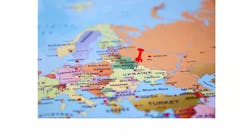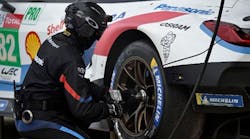For the first time since the turn of the century, the member federations of the European Union of Electrical Wholesalers (EUEW) saw some promising signs of recovery, with sales rising 5 percent for the 2004 fiscal year to approximately $34 billion (converted from euros). Average gross margin of the member national federations was 22 percent.
Although these sales figures indicate some moderate growth, delegates attending the EUEW's 50th General Assembly said this increase was due in part to rising copper and steel prices and the related price increases distributors were able to pass onto customers for products with high steel or copper content. Germany and Italy, two of the largest national markets in Europe, reported no gain in sales.
Industry observers and heads of the European national distributor trade associations believe slight volume increases would continue into the early part of 2006. In Europe, total sales volume by product group is predominated by 48 percent in electrical installation materials. The balance breaks out with 18 percent in lighting, 16 percent in wire and cable and 18 percent miscellaneous.
What preoccupies European distributors and manufacturers, however, are the regulatory directives that continue to be issued by the European Union (EU), Brussels, Belgium. One federation executive secretary labeled the regulations as “directives lacking direction.”
Multiple Directives
The Waste Electronic and Electrical Equipment (WEEE) directive presents an ongoing challenge to compliance according to both distributors and suppliers because a number of key issues have never been clarified, including who is responsible — the manufacturer, wholesaler, installer, or end-user — for the transport and processing of these waste materials.
Costs are another issue, and the so-called “visible fee” is a problem. Some manufacturers bundle the anticipated waste disposable costs into their base price while others treat it as a separate surcharge, so there is no uniformity either by country or company. The United Kingdom has lobbied for a postponement of compliance throughout the EU because there has been no meaningful agreement as to where in the supply chain responsibilities lie.
“Lighting manufacturers across Europe are arguing to make waste disposal a compulsory charge while wholesalers disagree,” said Nigel Ellis, executive director of the Electrical Distributors Association in the U.K. “But if a product comes back to the wholesaler as hazardous or toxic waste, then we will have to be licensed by the government to handle it, which will represent yet one more layer of cost and taxation for the distributor.”
Another issue is the variation in the visible fee from country to country. German and Austrian distributors, who engage in a significant amount of cross-border trade, are faced with reconciling a visible fee in Germany of approximately 48 cents per item and with the Austrian fee of approximately 30 cents per item.
With this complex situation not likely to be resolved in the near future, the electrical industry has been hit with a second regulatory challenge — the Energy Using Product (EUP) directive, which is a “green” issue and even less clear in how its objectives can be met. The target is to cut carbon-dioxide emissions from fossil fuel power generation 15 percent by 2010. It's an ambitious goal that no one has yet explained how to achieve. Manufacturers and wholesalers see both a problem and an opportunity in this scenario. Although it offers the possibility of promoting the use of more energy-efficient lamps and ancillary equipment, this leaves a major part of selling the entire concept to the public with members of the electrical supply chain.
Tracking the numbers
It's estimated that European wholesalers' sales in the European electrical marketplace account for approximately $41 billion, with direct sales by manufacturers and DIY/retail outlets dividing approximately $36 billion in additional sales equally.
The member federations of the EUEW represent 82 percent of the wholesaler universe in Europe, and as noted, accounted for approximately $34 billion, up 5 percent from last year. In total, 760 companies with 4,700 branch locations and 64,000 employees belong to these federations. Average sales volume of the companies, which include multinational chains and small independents, is about $45 million.
Executive directors of the individual federations provided the following sale reports for the last fiscal year:
Austria
Wholesalers saw a healthy 6.2 percent gain in overall sales to approximately $375 million, with gross margins static at 20 percent as the country's gross domestic product (GDP) advanced 2 percent and inflation doubled to 2.9 percent. Construction was strong, with residential business up 4.5 percent and the commercial market up 5.2 percent.
Belgium
Distributor volume was about $842 million, up 8 percent, and gross margins were 22 percent. The country experienced the largest GDP spike within the EUEW at 5 percent. Construction was off for the year, but this was offset by a 14 percent increase in sales of wire and cable and electronics including data networks, automation products and security equipment.
Finland
Sales advanced 4.7 percent to approximately $694 million with gross margins down fractionally to 20.9 percent, as GDP grew 3.7 percent. Overall construction was up 3 percent, with residential building doubling to 13 percent since last year. The national federation has partnered with three software companies to standardize product codes and classifications for use in the systems they sell to design engineers and installers.
France
Total volume was up 5.6 percent to $8.3 billion and gross margins were the highest in the union at 26.5 percent. GDP rose 2.5 percent. A 15.6 percent rise in residential construction accounted for much of the industry's growth over the period.
Germany
It was a flat year for wholesalers in Germany, with sales remaining at approximately $10 billion and gross margins at 22.2 percent. Overall construction activity was negative and bad debts were enough of an issue to prompt the national federation to enter a credit information exchange program with other trade associations.
Italy
Along with Germany, Italy merely retained its sales volume status quo, posting approximately $5.4 billion. Gross margins slipped slightly to 21.2 percent. The country's GDP was the lowest in the union at 0.5 percent, and construction work was slow, gaining only 1.3 percent.
Malta
Maltese wholesalers reported a respectable 8.3 percent increase in sales to approximately $22 million in their federation's first year as an EUEW member. Both residential and commercial construction were up 3 percent. A continuing strong export market to north African markets accounted for the strong performance.
Norway
Viking wholesalers continue to ride the gushing crest of the nation's North Sea oil bonanza with volume up 13 percent to approximately $1 billion and gross margins the highest in the EUEW at 25.7 percent. Total construction activity also led the group at 7.9 percent, with residential building leaping 29 percent after two years of stagnation.
Portugal
Sales moved up 3 percent to $363 million, with gross margins at 20 percent. GDP was the lowest of EUEW member countries, and wholesaler business was stalled by a third year of negative construction numbers, which were down 5 percent.
Spain
Spanish distributors saw a volume increase of 5.9 percent to $2.1 billion, but their gross margins were the lowest in the EUEW at 18 percent. An overall building hike of 4.4 percent was a positive development.
Sweden
Sales were up 6.2 percent to approximately $1.3 billion and gross margins rose slightly to 21.9 percent. The country's GDP advanced 3.5 percent with electronics leading the market segments with an increase of 13.4 percent.
Switzerland
Volume gained by 4.7 percent to approximately $510 million with gross margins of 23.2 percent. Construction work increased by 8.3 percent, the highest in EUEW. Of particular interest, almost 25 percent of distributors' sales are now generated via e-business in Switzerland.
United Kingdom
Volume inched up by only 1.2 percent over the previous year to approximately $3 billion, but gross margins increased by 1.5 percent to 22.5 percent, the largest annual gain in the EUEW. A 5 percent rise in construction and a healthy 3 percent GDP advance were the stabilizing factors.
John Paul Quinn is a free-lance writer and international communications consultant based in Stamford, Conn. He can be reached at (203) 323-9850 or via e-mail at [email protected].








